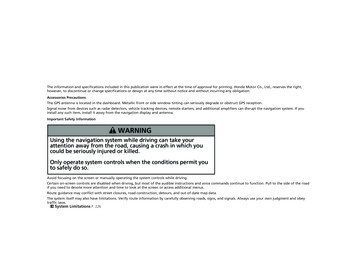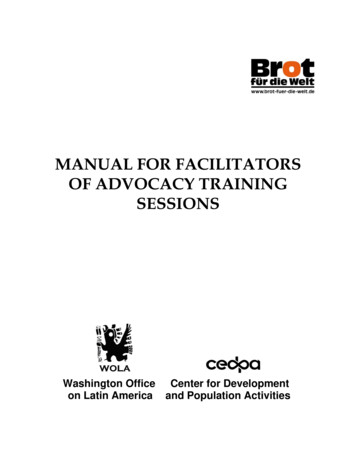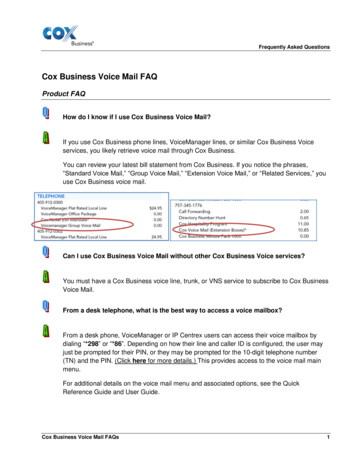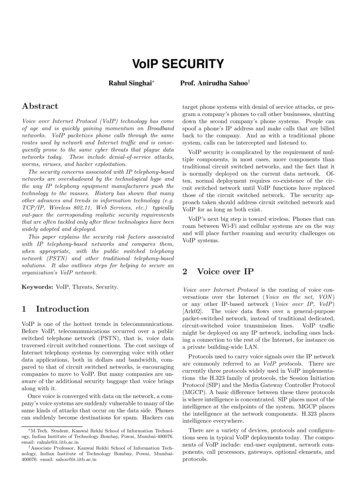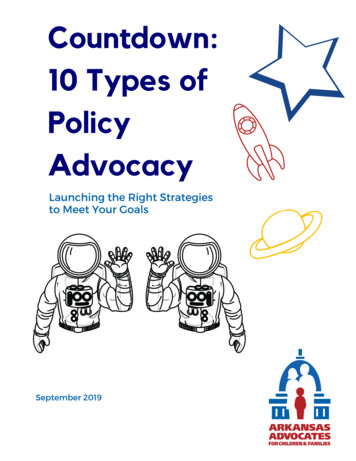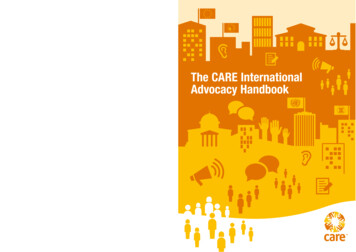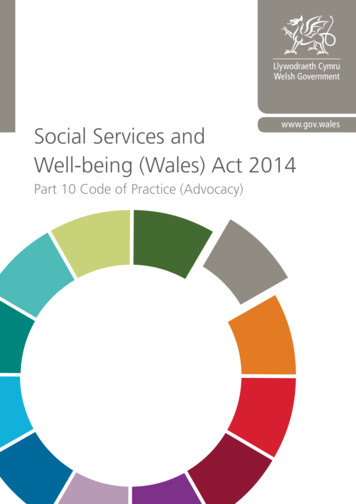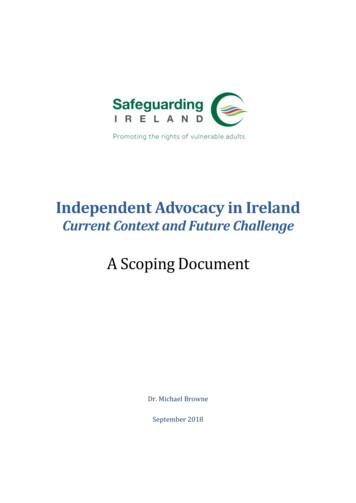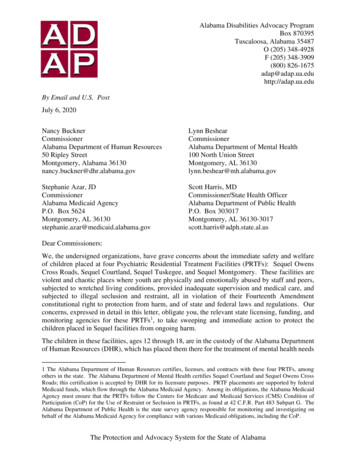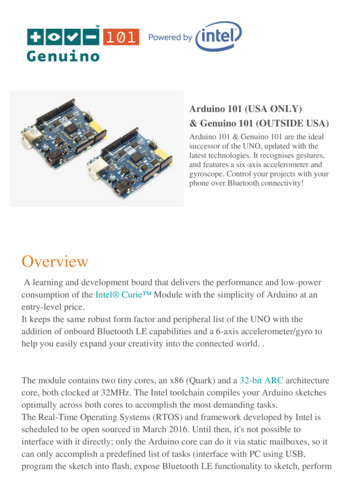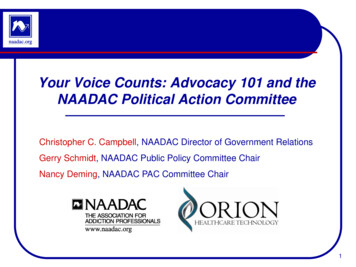
Transcription
Your Voice Counts: Advocacy 101 and theNAADAC Political Action CommitteeChristopher C. Campbell, NAADAC Director of Government RelationsGerry Schmidt, NAADAC Public Policy Committee ChairNancy Deming, NAADAC PAC Committee Chair1
Presented By2
Obtaining CE Credit The education delivered in this webinar is FREE to all professionals. 2 CEs are FREE to NAADAC members and AccuCare subscribers whoattend this webinar. Non-members of NAADAC or non-subscribers ofAccuCare receive 2 CEs for 25. If you wish to receive CE credit, you MUST download, complete andsubmit the “CE Quiz” that is located at: www.myaccucare.com/webinars A CE certificate will be emailed to you within 30 days of submitting thequiz. Successfully passing the “CE Quiz” is the ONLY way to receive a CEcertificate.3
Webinar ObjectivesDemonstrate the importance oflegislative advocacy Provide an update on the currentstatus of addiction-focused issuesand legislation Identify practical ways to become amore active and effective addictionpolicy advocate, including donating tothe NAADAC PAC 4
What is Advocacy? From Latin for “voice” Working definition: Advocacy is theprocess of influencing the public’sattitude towards a specific issue orgroup5
What is Advocacy?Individual-Driven Builds on the advocate’s individualstrengths Keeps in mind that individuals arealways the target—ultimately peoplemake decisions, not institutions6
What is Advocacy?―I have come to the conclusion that politics are tooserious a matter to be left to the politicians.‖-Charles de Gaulle7
Why Do Advocacy?The American System demands it (the First Amendment to theConstitution guarantees your right to petition the government). Legislators cannot be experts in everything, but they want tounderstand their constituents You have expert power no one else can give policymakers thefront-line information you have! – You are an expert on you! You give back to your profession, community, clients, andcountry Finally . No one else will do this for us8
Don’t Just Sit on the Sidelines Be an AdvocateA few more reasons to be an advocate.ChurchillData9
Sir Winston ChurchillSir Winston Churchill once said: “[I]t has been saidthat democracy is the worst form of governmentexcept all those other forms that have been tried fromtime to time.”This is the only system of government we have. Ifwe’re going to create change, we need to workthrough it.And that takes ALL of us working together.10
Slide 11source: “Communicating With Congress,” Congressional Management Foundation, 200511
Bonus Reason to Be an Advocate:The Power of One! Many times, a one-onone contact with alegislator or his/her staffdoes the job Like other humans,legislators’ decisionsare often based onpersonal experienceswith other individuals12
Successful Advocacy Movement: Parity On October 3, 2008, the Paul WellstoneMental Health Parity and Addiction EquityAct was signed into law This law represents the culmination of nearly15 years of advocacy by the mental healthand addiction treatment community,including NAADAC.13
Successful Advocacy Movement: ParityLong-term process 1996 law Introduced throughout 2000s 2007: Alignment! Rep. Jim Ramstad and Sen. Pete Domeniciretiring Democrats take control of the House and Senate Senate seeks insurance and business groups’support14
Successful Advocacy Movement: Parity Reps. Kennedy and Ramstad hold 14 informalhearings across the country Navigating the legislative process: 3 separatecommittees in House, unanimous consent in theSenate Informal negotiations Remaining issue: funding “offsets”15
Successful Advocacy Movement: ParityThe process of passing parity legislation helped position addictionand mental health prevention, treatment and recovery advocates topositively affect health care reform process It provided chance to educate Congress about importance ofaddiction and mental health services in context of the healthcare system Helped addiction and mental health advocates coordinate theirefforts Helped create minimum standard or “floor” of inclusion andequality for addiction and mental health that health reform tobuild upon16
The IssuesPriority policyissues thatNAADAC isworking on for ourmembers:Priority Issue 1:Ensuring that both theAffordable Care Act(ACA) and WellstonePete Domenici MentalHealth Parity andAddiction Equity (Parity)Act are fairly andeffectively implementedPriority Issue 2:Growing anddeveloping theaddictionprofessionalworkforce in the 21stcenturyPriority Issue 3:Increasing federaland state fundinglevels for addictiontreatment17
Priority Issue 1: Ensuring that Affordable CareAct is Fairly and Effectively Implemented The Affordable Care Act (ACA), signed into law by President Obama inMarch 2010, expands health insurance coverage to 32 million Americans,largely through state health insurance Exchanges for individuals and smallbusinesses, and through an expansion of Medicaid for low-incomeindividuals and families in 2014 ACA requires the plans in the Exchanges, as well as Medicaid expansionplans, to cover a set of “essential health benefits” that include “mentalhealth and substance use disorder [MH/SUD] services, including behavioralhealth treatment.” In other words, under the new law, services such asscreening, early intervention, treatment, and recovery support for patientswith substance use disorders will be provided in the same manner andin the same primary care settings as services for any other illness The change will bring needed help to many as it also increases awarenessthat drug dependence is a chronic, treatable disease18
Implementation of Affordable CareActNAADAC, along with other addictiongroups, is working to ensure the fullinclusion of substance use disorderservices within the Essential HealthBenefits package that will be offeredunder the ACA19
Priority Issue 1: Ensuring the Parity Actis Fairly and Effectively Implemented In October 2008, President Bush signed into law the PaulWellstone-Pete Domenici Mental Health Parity and AddictionEquity Act This historic law requires most insurance plans to provide thesame level of benefits for mental health and substance usedisorder services that they provide for other health careconditions Interim final regulations (IFR) implementing the law were issuedby HHS in February 2010, and took effect for most insuranceplans on Jan 1, 201120
Implementation of the Parity In May 2010, NADAC sent a letter to the HHS Secretarycommenting on the interim final regulations and seekingclarification on several issues In May 2011, several members of Congress wrote to HHS urgingthem to issue final regulations clarifying Congressional intent onscope of service, disclosure of medical criteria and nonquantitative treatment limitations NAADAC continues to advocate for final Parity regulationsthat provide strong protections for consumers, inaccordance with congressional intent21
Priority Issue 2: Growing and Developing theAddiction Professional Workforce in the 21st Century Under the Affordable Care Act, by 2014 approx. 32million more Americans will have health insurancecoverage, which will include treatment services forsubstance use disorders About 5 million of these newly insured will meet themedical diagnostic criteria for a substance use disorder Demand will rise for qualified and well-trainedaddiction professionals22
Priority Issue 2: Growing and Developing theAddiction Professional Workforce in the 21st Century Unfortunately, the addiction treatment workforce currentlyis not equipped to handle this influx There are an estimated 67,000 addiction-focusedclinicians in the U.S., and it is widely accepted that 5,000new counselors must enter the field every year in order tomaintain the current levels of service (and this does NOTtake into account the impact the ACA!) The DOL's BLS 2010-11 Occupational Outlook projectsemployment by 2018 to be 104,20023
Priority Issue 2: Growing and Developing theAddiction Professional Workforce in the 21st CenturyWhat Challenges Face the Addiction Workforce?Turnover ishigh. Theannual turnoverrate has beenestimated to beover 18 percent(11 percent isconsidered thenationalaverage)Compensationis low. Themedian incomeof addictioncounselors was 37,700( 19/hour) in2009Thedemographicsare skewed.About 70 percentof the workforce isfemale. Theaverage addictionprofessional is 4550 years old24
Priority Issue 2: Growing and Developing the AddictionProfessional Workforce in the 21st Century NAADAC is working to ensure that current andfuture addiction counselors receive the sameopportunities as other health professionals, such asfederal loan forgiveness and scholarship programs By ensuring that addiction counselors can competeon a level playing field additional counselors will beable to enter the profession and remain in their fieldof practice25
Priority Issue 3: Increasing Federal and StateFunding Levels for Addiction Treatment The Substance Abuse Prevention and Treatment BlockGrant (SAPT) is single largest funding stream for statetreatment programs and the most important program thatprovides addicted individuals treatment The SAPT Block Grant serves our nation’s mostvulnerable, low-income populations Funding for the SAPT Block Grant has been stagnant forthe last several years, yet the demand for servicescontinues to rise26
Priority Issue 3: Increasing Federal and StateFunding Levels for Addiction TreatmentSAPT BLOCK GRANT FUNDING2005 1,775,554,7202006 1,757,425,4462007 1,758,591,0002008 1,758,727,9392009 1,778,591,0002010 1,778,591,0002011 1,778,591,00027
Priority Issue 3: Increasing Federal and StateFunding Levels for Addiction TreatmentNAADAC, as part of the Addiction Leadership Group,is calling on Congress to:o Maintain the existing structure of the Substance AbusePrevention and Treatment (SAPT) Block Grant, with a 20percent set aside for substance abuse prevention, asmandated in current law, ando Increase total funding for the SAPT by 50 million from 1,798.5 m in FY 2011 to 1,848.5m in FY 201228
Taking ActionQ.“Which is the best way ofcontacting legislators: phone,fax, e-mail, letters, or visits?”A. Yes.29
Before Picking up the Phone(or Keyboard) Check the status of the legislation on NAADAC’s website(www.naadac.org), and likely next steps Find out if your legislator has taken a position on thelegislation (e.g., cosponsored the legislation) Find out if your legislator sits on a committee withjurisdiction over the bill Check NAADAC’s website for stats/arguments supportingyour position30
Ask for Specific, Verifiable ActionAsk your member of Congress to Offer an amendment during floor consideration or a committee mark-up Send a “Dear Colleague” letter on your issue Speak in favor of your position in public Find a colleague on the other side of the aisle to work with Talk/write to committee chair about your bill Talk/write to Administration office about your issue Introduce a bill Cosponsor a bill Cosign a letter on your issue31
Calling Your Members of Congress All Senators’ and Representatives’ officescan be contacted through the U.S. CapitolSwitchboard at (202) 224-3121. Consider plugging your delegations’ directphone numbers into your cell phone. District Office calls work too, and are not longdistance.32
Calling Your Members of Congress Give your name and identify yourself as a constituent. Ask for something specific. If possible, relate anecdotes or describe your personalexperiences relevant to the issue Leave your mailing address (very important!) Say that you’d like to hear back from the Senator (orRepresentative) on the issue33
Contacting Your Members of Congress Keep letters to one or two pages, tops Stick to one issue Always include your name and mailing address Ask for something specific Keep a copy of your e-mail or letter for future reference Consider faxing your letter34
Communications to Capitol Hill,1995-2006source: Congressional Management Foundation, 200835
INDIVIDUALIZED contacts still work 36source: “Communicating With Congress,” Congressional Management Foundation, 2005
Quotes from House correspondence staffers:“One hundred form letters have less direct value than asingle thoughtful letter generated by a constituent of theMember’s district.”“Form letters are a waste of everyone’s time. What wecare about is that a constituent not only took the time towrite a communication to us, but that he/sheunderstands the fundamentals of the issue at hand andmakes a rational, well-conceived argument for theposition.”CMF report: “Quality is more persuasive than quantity . The contentmatters. The operating assumption of many congressional staff is thatthe more time and effort constituents take to communicate, the morepassionately they care about the issue.”37source: “Communicating With Congress,” Congressional Management Foundation, 2005
The Waiting Game You WILL NOT hear back for AT LEAST 3 - 4weeks If/when you hear back, it’s likely to be a formletter If you don’t hear back within three weeks,and/or get a form letter, contact the office again The squeaky wheel gets the grease38
Three Top Rules for Advocacy SuccessFollow upFollow upFollow upThe lobbying visit, phone call, letter, or e-mail initself is NOT the end point of engaging in advocacy.The end point is getting a concrete, specific answerfrom the legislator/bureaucrat on your particularrequest.39
Ways of Being an Advocate Phone call Extend a speaking invitation E-mail Write a letter to the editor Letter Speak before a committee Lobbying visit Join a community group Volunteer on a politicalcampaign Run for office Post a yard sign Contribute money(NAADAC PAC) Get a bumper sticker Stage a protest Speak about politics to yourfriends/family/neighbors Participate in a march Hold a press conference Send legislator yournewsletter40
Ways of Being an Advocate:NAADAC PAC The NAADAC Political Action Committee (PAC) was foundedover two decades ago and is the oldest, most established PAC tofocus exclusively on addiction policy issues PAC donations are a unique advocacy tool that helps make yourvoice--the voice of addiction professional—be heard on CapitolHill The PAC supports members of Congress who championaddiction services and addiction professionals However, NAADAC PAC is only as effective as the support itreceives from members. The PAC is funded exclusivelydonations from members like you!41
Ways of Being an Advocate:NAADAC PAC In the past, NAADAC PAC has supported Membersof Congress who have helped advance bills onissues like expanding treatment access to allAmericans, ending insurance discrimination againstaddiction treatment, and increasing funding forpublic treatment systems NAADAC PAC also enables us to educate andbuild relationships with Senators andRepresentatives42
Ways of Being an Advocate:NAADAC PACAlthough NAADAC PAC cannot donateat the same level as the nation’slargest PACs, it gives addictionprofessionals (and, by extension, theaddiction treatment community) apresence in Washington that they couldnot otherwise have.43
Ways of Being an Advocate:NAADAC PACFurther, the PAC creates unique opportunities forNAADAC: It enables our advocacy staff to spend time one-on-one withlegislators and their staffs at fundraising events, talking aboutissues like insurance parity and protecting public funding fortreatment It helps NAADAC develop relationships with members ofCongress and their aides, as well as ensuring that membersof Congress who support our policies are re-elected The PAC is irreplaceable and complements all otheradvocacy work44
Ways of Being an Advocate:NAADAC PAC From September 1 - 30, 2011,NAADAC PAC is hosting itsThird Annual PAC Drive There’s no better time tosupport the PAC than duringthe PAC Drive! All donors are entered to winprizes45
Ways of Being an Advocate:NAADAC PAC Donations can be madeonline atwww.naadac.org/advocacy Or, by filling out a PAC Drivebrochure and mailing it toNAADAC46
How NAADAC Can Help Newly revised “Advocacy” section of NAADAC’swebsite (www.naadac.org) Policy briefs CapWiz E-Advocacy Center (www.capwiz.com/naadac):sign-up for e-alerts, find your Members of Congress, plustrack federal legislation Addiction Professional public policy blog atwww.AddictionPro.com Interactive and with comments47
How NAADAC Can Help National Committees (members listed on website) NAADAC PAC Committee NAADAC Public Policy Committee State Advocacy Liaisons Work with both NAADAC Govt. Relations Dept. and yourstate affiliate to (1) track state-level legislative issues and (2)mobilize your state’s grassroots when there’s a nationalissue that requires action48
How NAADAC Can Help Articles in Addiction Professional andNAADAC News, among others Access to NAADAC GovernmentRelations Department:ccampbell@naadac.org, 800.548.0497x12949
Questions and Discussion50
Upcoming Webinars 2011 October 13, 2011 - Conflict Resolution for Clients andProfessionals November 17, 2011 – Health Information Technology(HIT) December 15, 2011 - Clinical Supervision: Keys toSuccessRegister at: www.naadac.org/education or www.myaccucare.com/webinars51
Archived Webinars Alcohol SBIRT: Integrating Evidence-based Practice Into Your Practice Medication Assisted Recovery: What Every Addiction Professional Needs to Know Build Your Business With the Department of Transportation Substance Abuse Professional(SAP) Qualification Working with NAADAC to Express Your Professional Identity Screening, Brief Intervention and Referral to Treatment (SBIRT) Medicaid Expansion 2014 and Preparing to Bill for Medicaid Understanding NAADAC’s Code of Ethics Staying Informed: Trends in the Addiction Profession Co-occurring DisordersArchived webinars located at: www.naadac.org/education orwww.myaccucare.com/webinars52
The clinical tools you need. The customer support you deserve.That’s why Orion Healthcare Technology is the preferred software vendor of NAADAC.Assessments and ScreeningTreatment PlanningProgress NotesInsurance Billingwww.MyAccuCare.comCall: (800)324-7966Prevention TrackingSchedulingData Analysis53
Obtaining CE Credit The education delivered in this webinar is FREE to all professionals. 2 CEs are FREE to NAADAC members and AccuCare subscribers whoattend this webinar. Non-members of NAADAC or non-subscribers ofAccuCare receive 2 CEs for 25. If you wish to receive CE credit, you MUST download, complete andsubmit the “CE Quiz” that is located at: www.myaccucare.com/webinars A CE certificate will be emailed to you within 30 days. Successfully passing the “CE Quiz” is the ONLY way to receive a CEcertificate.54
Thank You for Participating!Chris Campbell - chris@naadac.orgGerry Schmidt - gschmidt@valleyhealthcare.orgNancy Deming - ndeming@valleyhealthcare.org1001 N. Fairfax Street., Ste. 201Alexandria, VA 22314phone: 703.741.7686/800.548.0497fax: ac.orgMisti Storie: misti@naadac.org1016 Leavenworth StreetOmaha, NE 68102phone: 402.341.8880fax: .comBrittany Bengtson:bbengtson@orionhealthcare.com55
2 CEs are FREE to NAADAC members and AccuCare subscribers who attend this webinar. Non-members of NAADAC or non-subscribers of . of practice Priority Issue 2: Growing and Developing the Addiction Professional Workforce in the 21st Century . 26 . Congressional Management Foundation, 2008 .
